

InfluxCloud Trial. Transaction In Doubt. Rules/reference.md at master · jruizgit/rules. Durable_rules. Durable_rules is a polyglot micro-framework for real-time, consistent and scalable coordination of events.
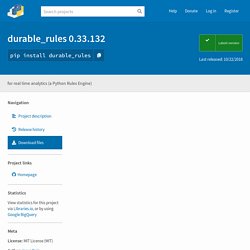
With durable_rules you can track and analyze information about things that happen (events) by combining data from multiple sources to infer more complicated circumstances. A full forward chaining implementation (A.K.A. Rete) is used to evaluate facts and massive streams of events in real time. A simple, yet powerful meta-liguistic abstraction lets you define simple and complex rulesets as well as control flow structures such as flowcharts, statecharts, nested statecharts and time driven flows.
The durable_rules core engine is implemented in C, which enables ultra fast rule evaluation as well as muti-language support. durable_rules relies on state of the art technologies: Werkzeug( is used to host rulesets). Venmo/business-rules: Python DSL for setting up business intelligence rules that can be configured without code. Tb3. The Best Technical Analysis Trading Software. There are those who say a day trader is only as good as his charting software.
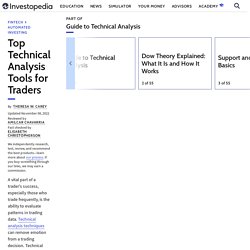
While that's debatable, it's certainly true that a key part of a trader's job – like a radiologist's – involves interpreting data on a screen; in fact, day trading as we know it today wouldn't exist without market software and electronic trading platforms. A lot of software applications are available from brokerage firms and independent vendors claiming varied functions to assist traders. Most brokerages offer trading software, armed with a variety of trade, research, stock screening and analysis functions, to individual clients when they open a brokerage account.
In fact, the bundled software applications – which also boast bells-and-whistles like in-built technical indicators, fundamental analysis numbers, integrated applications for trade automations, news, and alert features – often act as part of the firm's sales pitch in getting you to sign up. Top 7 Books to Learn Technical Analysis. There are a wide range of books available for learning technical analysis, covering topics like chart patterns, crowd psychology, and even trading system development.
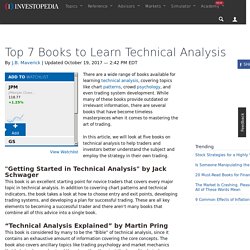
While many of these books provide outdated or irrelevant information, there are several books that have become timeless masterpieces when it comes to mastering the art of trading. In this article, we will look at five books on technical analysis to help traders and investors better understand the subject and employ the strategy in their own trading. How To Launch Your Own Production-ready Cryptocurrency. Redacademy/vue-ethereum-ipfs: Distributed Application Starter: Vue front-end, Ethereum / IPFS Backend. Quantdom 0.1a1. Simple but powerful backtesting framework, that strives to let you focus on modeling financial strategies, portfolio management, and analyzing backtests.
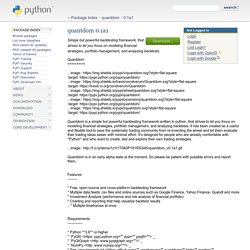
Quantdom======== .. image:: :target: image:: :target: image:: :target: image:: :target: image:: :target: Quantdom is a simple but powerful backtesting framework written in python, that strives to let you focus on modeling financial strategies, portfolio management, and analyzing backtests. It has been created as a useful and flexible tool to save the systematic trading community from re-inventing the wheel and let them evaluate their trading ideas easier with minimal effort. It's designed for people who are already comfortable with *Python* and who want to create, test and explore their own trading strategies. .. image:: Quantdom is in an early alpha state at the moment.
Features-------- Requirements------------ Hardikp/scrapy-finance: scrapy spiders to crawl the financial text data pertinent to train word vectors. Rgormisky/FinancialNewsSentiment: Scripts for querying financial news sources and extracting topics and sentiment using NLP methods. Maximedb/nlp_papers: NLP papers applicable to financial markets. SentiWordNet. Pattern. Pattern is a web mining module for the Python programming language. It has tools for data mining (Google, Twitter and Wikipedia API, a web crawler, a HTML DOM parser), natural language processing (part-of-speech taggers, n-gram search, sentiment analysis, WordNet), machine learning (vector space model, clustering, SVM), network analysis and <canvas> visualization.
The module is free, well-document and bundled with 50+ examples and 350+ unit tests. Download Installation Pattern is written for Python 2.5+ (no support for Python 3 yet). To install Pattern so that the module is available in all Python scripts, from the command line do: > cd pattern-2.6 > python setup.py install If you have pip, you can automatically download and install from the PyPi repository: If none of the above works, you can make Python aware of the module in three ways: Quick overview pattern.web pattern.en The pattern.en module is a natural language processing (NLP) toolkit for English. Pattern.search pattern.vector Case studies. Pattern. Sentiment analysis of financial news articles in Python (part 1) In this article we are going to compare and contrast the most popular design approaches to building an automated trading system based on sentiment analysis of financial news.
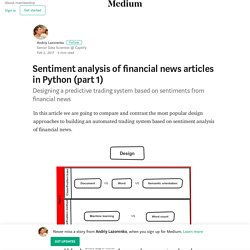
As can be seen from the above diagram, there are many ‘degrees of freedom’ for such a system, which can affect the model’s performance drastically. 1. Classification base and method When splitting the data for the analysis, we have to decide on what is our fundamental information-containing unit. The candidates are: words, documents and a subtle model of semantic orientation, which can be viewed as a variation of ‘words as a base’ approach. Words + word count When using words as information-carrying particles, we assume that each individual word in a financial article carries on its own some information that might be used to predict future price of a stock. It is necessary to point out, that fixed lexicons of words along with sentiment labels assigned to them lead to inaccurate overall results.
To be continued … Predicting Cryptocurrency Prices With Deep Learning - dashee87.github.io. Science Trader's Blog: Some more analysis. One of the reasons that led to my decision to terminate my portfolio was some analysis I did last week.
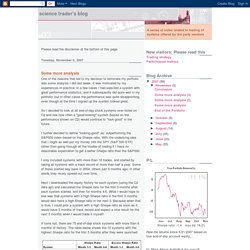
Time series analysis with pandas. Here I am going to show just some basic pandas stuff for time series analysis, as I think for the Earth Scientists it's the most interesting topic.
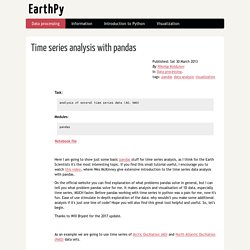
If you find this small tutorial useful, I encourage you to watch this video, where Wes McKinney give extensive introduction to the time series data analysis with pandas. On the official website you can find explanation of what problems pandas solve in general, but I can tell you what problem pandas solve for me. It makes analysis and visualisation of 1D data, especially time series, MUCH faster. Before pandas working with time series in python was a pain for me, now it's fun. Ease of use stimulate in-depth exploration of the data: why wouldn't you make some additional analysis if it's just one line of code? Thanks to Will Bryant for the 2017 update.